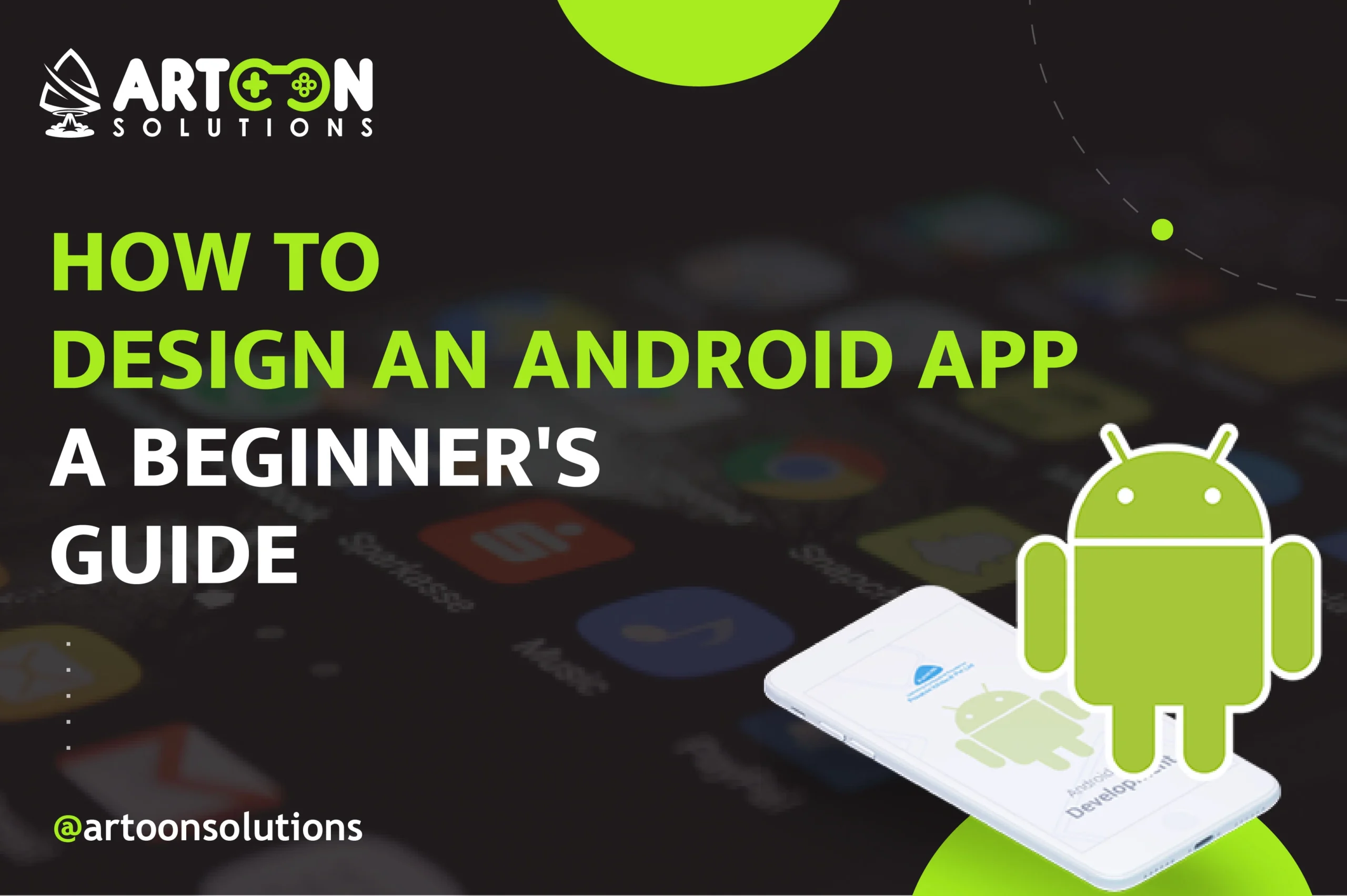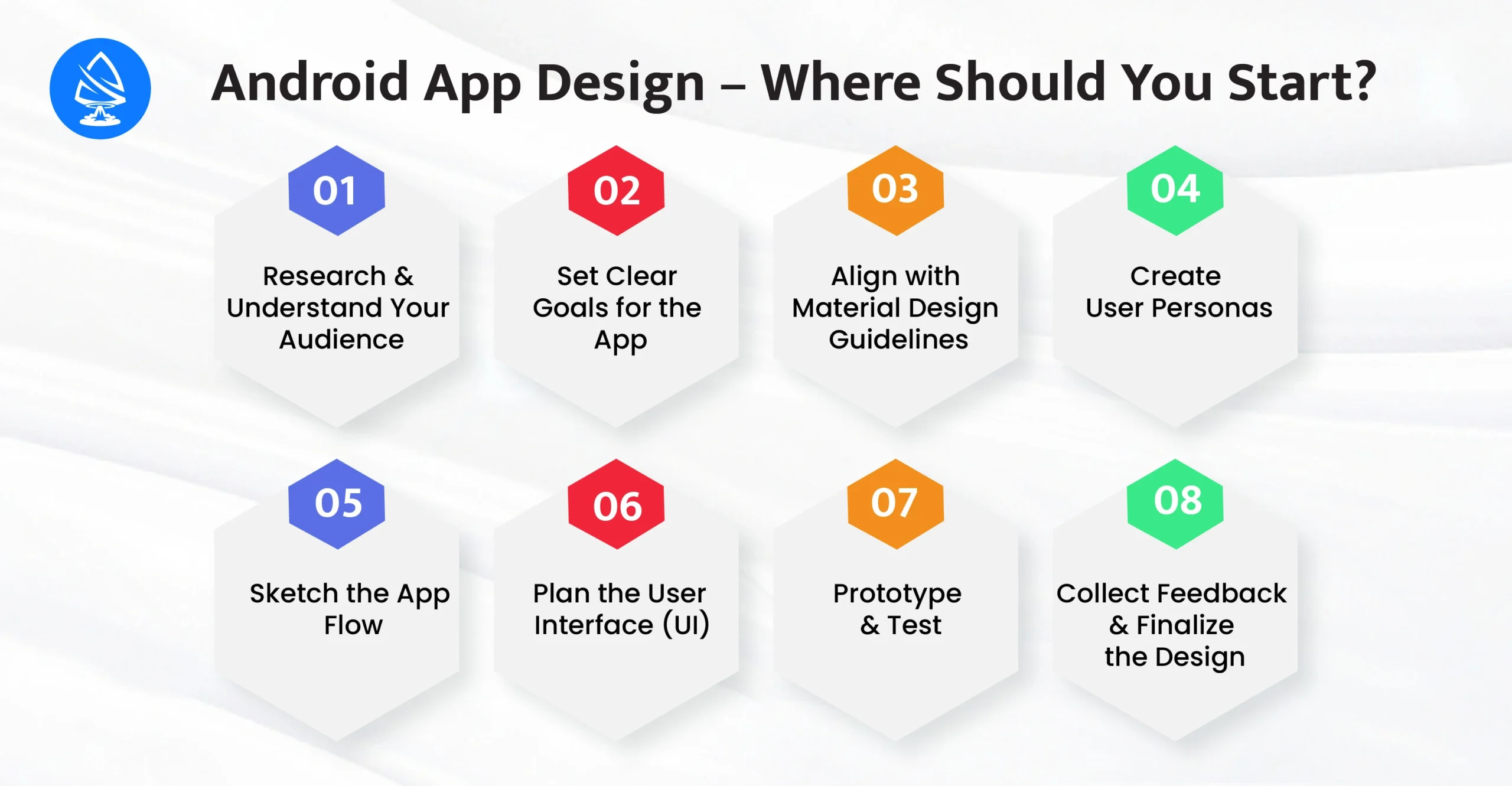- HR:+91-879-9184-787
- Sales:+91-908-163-7774

Have you ever wondered what goes into designing an Android app? With billions of smartphone users worldwide, Android continues to dominate the market, holding nearly 74% market share in 2024. This massive user base makes Android app development a key focus for businesses aiming to reach a global audience.
Designing an Android app requires creativity, user-centric thinking, and understanding essential design principles to make the app visually appealing and functional.
It’s important to choose the right development partner to get started on designing an Android app. Working with a trusted Android app development company can ensure that your vision turns into reality!
Now, let’s dive into the details of Android app design to help you understand where to begin and how to approach the process effectively.
Android app design refers to the process of creating an Android application’s visual and interactive aspects. This includes various elements such as the layout, color schemes, buttons, icons, and other interactive components that users engage with while using the app.
The objective of Android app design is to ensure a seamless user experience (UX) along with an aesthetically pleasing user interface (UI). This makes the app easier to navigate, improving overall user satisfaction and retention.
The key factors in Android app design include:
Whether designing an app for Android or comparing iOS vs Android development, maintaining this balance between usability and aesthetics ensures that the app not only looks great but also performs its intended functions efficiently.
Designing an Android app requires careful planning and a structured approach. Before diving into the design process, it’s important to set a clear foundation.
Here’s a step-by-step guide to help you start designing an Android app effectively:

The first and most crucial step in designing an Android app is conducting thorough research. This helps you understand your target audience, their preferences, behaviors, and pain points. The more you know about your potential users, the better equipped you will be to design an app for Android.
Key points to focus on during the research phase:
To further solidify your research, analyze your competitors. Identify what works well in similar apps and areas where you can improve or innovate. By examining existing apps, you can gain valuable insights into successful design strategies and avoid common pitfalls.
Once you’ve conducted research, the next step is to define the app’s purpose and goals. Consider the following questions:
These goals will guide your design decisions and ensure the app serves its intended purpose.
Google’s material design guidelines provide a solid foundation for designing an Android app. These guidelines focus on:
Adhering to these principles ensures that your design remains consistent with Android’s overall ecosystem, making it easier for users to navigate your app intuitively.
Creating user personas, fictional characters representing different user types who might use your app can help before moving into an actual design. Each persona will have distinct goals, preferences, and behaviors.
For example, one persona might be a busy professional who uses the app for quick tasks. At the same time, another might be a tech-savvy teenager who enjoys interactive features. Designing with these personas in mind helps ensure the app will cater to diverse user needs.
Now that you have a solid understanding of your audience and goals, it’s time to start visualizing the app’s structure. This begins with sketching out the user flow. This includes the path users will take from one screen to another to achieve their objectives.
Use wireframes, which are simple, visual representations of your app’s layout, to:
Wireframes are crucial because they help you visualize the app’s structure and user journey before diving into detailed design work. Tools like Figma, Sketch, or Adobe XD can be helpful for wireframing. There are various free app builder which can be helpful for the beginners!
After finalizing the app’s flow, you can move on to designing the User Interface (UI). This includes deciding on the layout, typography, and visual elements that will make your app visually appealing. Here’s what to consider:
At this stage, you will also need to consider device compatibility. Android apps run on a wide variety of devices with different screen sizes and resolutions, so your design needs to be responsive and adaptive.
Before finalizing your design, it’s essential to create a prototype. A prototype is an interactive model of your app that allows you to test how the design will work in real life.
Once you’ve gathered enough feedback and made the necessary improvements, you can finalize the app’s design. At this stage, all elements should be polished, and the app should be ready for development.
Make sure the design is consistent, follows material design guidelines, and works well across different devices. Your design should focus on both aesthetics and user functionality to deliver a great experience.
By following these steps, you’ll be well on your way to creating a successful Android app design!
Several design elements must come together to create a well-functioning and visually appealing Android app. These include:
Designing an Android app differs significantly from web apps and iOS apps, primarily due to platform-specific guidelines and capabilities.
The Web apps are accessed via browsers and work across different platforms without needing to be downloaded from app stores. They are more flexible in design but can’t fully utilize device hardware like GPS or the camera, which limits performance.
Web apps are typically easier to maintain as they are universal. Still, they lack the integration and performance advantages of native apps.
Native Android apps are built specifically for Android, adhering to material design principles, which emphasize simplicity, bold visuals, and responsive layouts. In other words Native apps can fully utilize Android devices’ hardware features, providing better performance, smoother animations, and offline capabilities.
They are optimized for the Android operating system, offering a more integrated and reliable user experience.
The Android applications follow material design guidelines, which focus on bold colors, clear hierarchies, and depth using shadows.
Designers need to consider Android’s wide variety of device types and customizations. This includes different screen sizes, resolutions, and user navigation preferences.
Apple iOS apps adhere to Apple’s Human Interface Guidelines (HIG), which emphasize clarity, minimalism, and depth.
The iOS apps tend to use softer visuals and prioritize fluid, gesture-based navigation. Since iOS operates on fewer devices, it offers more design uniformity, reducing the complexity that comes with Android’s device fragmentation.
The design landscape constantly evolves. Staying updated with the latest trends ensures your app remains relevant and appealing. Here are some popular design trends for Android apps:
To design an app for Android effectively, you need the right tools. Here are some of the top options:
These tools allow for creating a cohesive design process without much hassle.
Artoon Solutions specializes in offering Android app development services tailored to your business’s unique needs.
From the initial research and concept to UI/UX design and final implementation, our team of experienced designers and developers ensures that your app not only looks great but also performs flawlessly across various devices. As a leading Android app development agency, we understand the intricacies of Android design and development.
Whether you’re looking to hire Android app developers or iOS app developers, having expert support is a must! Artoon Solutions is your trusted partner in creating apps that stand out in the competitive Android marketplace!
Define your app’s purpose, create wireframes, follow Material Design guidelines, and use design tools like Figma or Sketch.
Yes, there are free design tools like Figma and Adobe XD that offer basic features to help you design an Android app for free. Some tools have premium versions for advanced features.
Learn Java/Kotlin, set up Android Studio, design your app, code it, test it, and then publish it on Google Play.
Costs range from $5,000 to $50,000+, depending on complexity. DIY costs are lower, but they involve time and learning. You can get expert help from Android app development companies like Artoon Solutions.
It can be challenging for beginners but manageable with learning and dedication. Complex apps require more skill!
Copyright 2009-2025